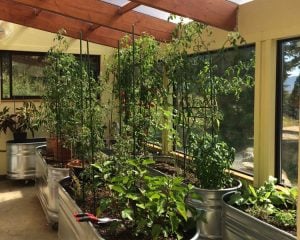When inspired to grow something that just is not suited to their climate, many gardeners are seized by a Rube-Goldberg-like creative fever to come up with any contraption that will get them to their goal. Often it goes beyond growing under glass, and has done so for generations.
Enchanted by the idea of growing lemons, limes, grapefruit…citrus of all sorts, following a visit to the beautiful 16th-century Villa Medici Castello, on the outskirts of Florence, Italy, I reasoned with myself that if Cosimo de Medici’s lemon trees could survive a dank Florentine winter in the half light of a dusty limonaia (lemon house), I could surely swing it with one small tree in a manageable pot in a sort-of-sunny room in Pennsylvania. And indeed I did; the room was filled with delicious fragrance all winter, and come spring, the blooms turned to infant fruit, the prefect size (eventually) for a small gin and tonic. Memory of this success, and the sweetness of the perfume warming the dark winter afternoons, has not left me. Neither has the notion that a sunny window in a centrally heated house is the simplest manifestation of growing what you ain’t supposed to.

The appliance of science during the age of reason – and the expansion of empire, which brought previously unknown treasures into the gardener’s world – advanced horticultural techniques. The most determined used not only a hotbed, which is nothing more than a pit filled with heat-generating, rotting manure into which pot-grown specimens were plunged, but also the sophisticated refinement of heated walls. These structures had pipes running between double walls carrying heat from coal fires stoked day in and day out by the lowliest skivvy in the garden, the potboy. Falling asleep on the job and letting the fire go out and the pineapples shrivel was punishable by a sound beating.

So, considering the unpredictable weather in my state of Colorado and researching the affordable options (no, I won’t be running central heating ducts into a greenhouse, or plugging into the grid…if I can help it), I came upon the story of Russ Finch and his geothermal greenhouse in the high plains of western Nebraska, where temperatures range from hellishly hot to brutally cold. But by sinking the floor of his greenhouse four feet below the surface Russ draws upon the Earth’s natural heat, which at eight feet deep is 52 degrees Fahrenheit. At four feet, though, it’s just right for maintaining steady temperatures day and night, as evidenced by the veritable grove of citrus he tends on the Nebraska prairie. By slanting one wall of the structure to the south, Finch incorporates passive solar in the greenhouse plan to ensure maximum use of renewable energy.
Oddly, you’d be wrong if you thought food production under glass would be water-intensive and impractical. It’s not; it’s the heating and light that sucks up energy. But using traditional methods of heating (think of the pot boy and his coal-fired hot walls) would contribute to the appositely named “greenhouse effect.” That’s no joke, and a most compelling reason to go geothermal/solar. It also opens up food production in this and many other challenged regions, with the potential of making nutrious but exotic foods more widely and affordably available. Finch explains: “There’ve been hardly any successful 12-month greenhouses on the northern High Plains. The cost of energy is too high for it. But by tapping into the Earth’s heat, we’ve been able to drastically reduce the cost.” Necessity, it’s said, is the mother of invention. No kidding!

Text ©Ethne Clarke, 2016










